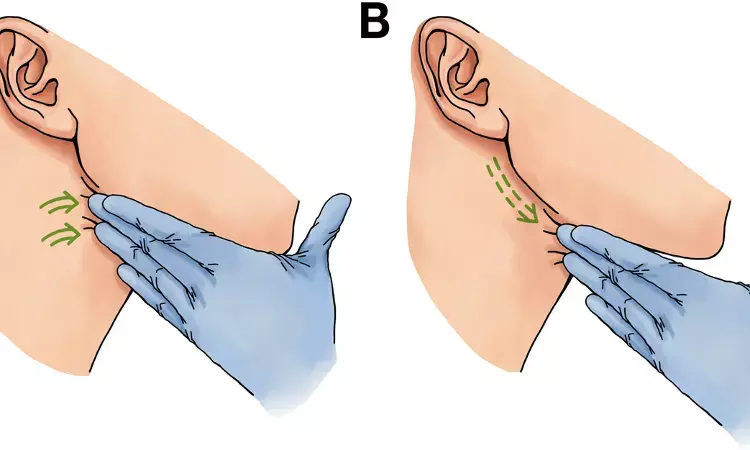- Home
- Medical news & Guidelines
- Anesthesiology
- Cardiology and CTVS
- Critical Care
- Dentistry
- Dermatology
- Diabetes and Endocrinology
- ENT
- Gastroenterology
- Medicine
- Nephrology
- Neurology
- Obstretics-Gynaecology
- Oncology
- Ophthalmology
- Orthopaedics
- Pediatrics-Neonatology
- Psychiatry
- Pulmonology
- Radiology
- Surgery
- Urology
- Laboratory Medicine
- Diet
- Nursing
- Paramedical
- Physiotherapy
- Health news
- Fact Check
- Bone Health Fact Check
- Brain Health Fact Check
- Cancer Related Fact Check
- Child Care Fact Check
- Dental and oral health fact check
- Diabetes and metabolic health fact check
- Diet and Nutrition Fact Check
- Eye and ENT Care Fact Check
- Fitness fact check
- Gut health fact check
- Heart health fact check
- Kidney health fact check
- Medical education fact check
- Men's health fact check
- Respiratory fact check
- Skin and hair care fact check
- Vaccine and Immunization fact check
- Women's health fact check
- AYUSH
- State News
- Andaman and Nicobar Islands
- Andhra Pradesh
- Arunachal Pradesh
- Assam
- Bihar
- Chandigarh
- Chattisgarh
- Dadra and Nagar Haveli
- Daman and Diu
- Delhi
- Goa
- Gujarat
- Haryana
- Himachal Pradesh
- Jammu & Kashmir
- Jharkhand
- Karnataka
- Kerala
- Ladakh
- Lakshadweep
- Madhya Pradesh
- Maharashtra
- Manipur
- Meghalaya
- Mizoram
- Nagaland
- Odisha
- Puducherry
- Punjab
- Rajasthan
- Sikkim
- Tamil Nadu
- Telangana
- Tripura
- Uttar Pradesh
- Uttrakhand
- West Bengal
- Medical Education
- Industry
TORS safe and effective modality for sialolithotomy with high success rate

Transoral robotic surgery (TORS) safe and effective modality for sialolithotomy with high success rate suggests a new study published in the Journal Of Clinical Medicine.
This study aimed to systematically review the literature to determine the efficacy and safety of transoral robotic surgery (TORS) in the management of submandibular gland (SMG) sialolithiasis. PubMed, Embase, and Cochrane were searched for English-language articles evaluating TORS in the management of SMG stones published up to 12 September 2022.
Sialolithiasis represents the most common cause of obstructive salivary gland disorders [1]. While postmortem studies indicate a 0.115% prevalence of sialoliths in the general population, their clinical (symptomatic) prevalence amounts to 0.45% [1,2,3]. Most salivary stones (as high as 80–90% of cases) affect the submandibular gland (SMG), with a preferential location in the distal third of the Wharton’s duct, at the hilum or in the hilo-parenchymal area of the SMG
Nine studies with a total of 99 patients were included. Eight patients underwent TORS followed by sialendoscopy (TS); 11 patients underwent sialendoscopy followed by TORS and sialendoscopy (STS); 4 patients underwent sialendoscopy followed by TORS only (ST); and 4 patients underwent TORS without sialendoscopy (T). The mean operative time amounted to 90.97 min. The mean procedure success rate reached 94.97%, with the highest for ST (100%) and T (100%), followed by the TS (95.04%) and STS (90.91%) variants. The mean follow-up time was 6.81 months. Transient lingual nerve injury occurred in 28 patients (28.3%) and was resolved in all of them within the mean of 1.25 months. No permanent lingual nerve injury was reported. TORS is a safe and effective management modality for hilar and intraparenchymal SMG sialoliths, with high procedural success in terms of successful sialolith removal, SMG preservation, and reduced risk of permanent postoperative lingual nerve damage.
Reference:
Rogalska M, Antkowiak L, Kasperczuk A, Scierski W, Misiolek M. Transoral Robotic Surgery in the Management of Submandibular Gland Sialoliths: A Systematic Review. Journal of Clinical Medicine. 2023; 12(8):3007. https://doi.org/10.3390/jcm12083007
Keywords:
TORS, safe, effective, modality, sialolithotomy, high success rate, Rogalska M, Antkowiak L, Kasperczuk A, Scierski W, Misiolek M, sialolithotomy; sialendoscopy; robot-assisted; sialolithiasis; submandibular stones; lingual nerve
Dr. Shravani Dali has completed her BDS from Pravara institute of medical sciences, loni. Following which she extensively worked in the healthcare sector for 2+ years. She has been actively involved in writing blogs in field of health and wellness. Currently she is pursuing her Masters of public health-health administration from Tata institute of social sciences. She can be contacted at editorial@medicaldialogues.in.
Dr Kamal Kant Kohli-MBBS, DTCD- a chest specialist with more than 30 years of practice and a flair for writing clinical articles, Dr Kamal Kant Kohli joined Medical Dialogues as a Chief Editor of Medical News. Besides writing articles, as an editor, he proofreads and verifies all the medical content published on Medical Dialogues including those coming from journals, studies,medical conferences,guidelines etc. Email: drkohli@medicaldialogues.in. Contact no. 011-43720751


